Strategic Analysis of the Australian Tourism and Hospitality Industry
VerifiedAdded on 2021/02/11
|9
|2174
|362
Report
AI Summary
This report provides a detailed analysis of the Australian tourism and hospitality sectors, examining their performance, challenges, and future prospects. It begins with an executive summary highlighting the impact of the COVID-19 pandemic on revenue growth and the government's role in promoting tourism. The report then delves into a critical analysis of current strategic and leadership risks, including the rise of sharing economy models like Airbnb, staff shortages, and customer risk perceptions. It evaluates the strengths and weaknesses of the Australian tourism industry, addressing issues such as cultural attractions, airport limitations, and the need for commercialization. The report also explores the problems faced by the industry in restarting tourism after COVID-19, economic costs, and key sustainability indicators. It examines the 'Tourism 2030' strategy, outlining its vision, mission, strategic framework, and long-term goals. The report further discusses relevant theories and concepts in the context of the hospitality industry, including best practices in HRM. Finally, it references various sources, including government websites and research papers, to support its findings.
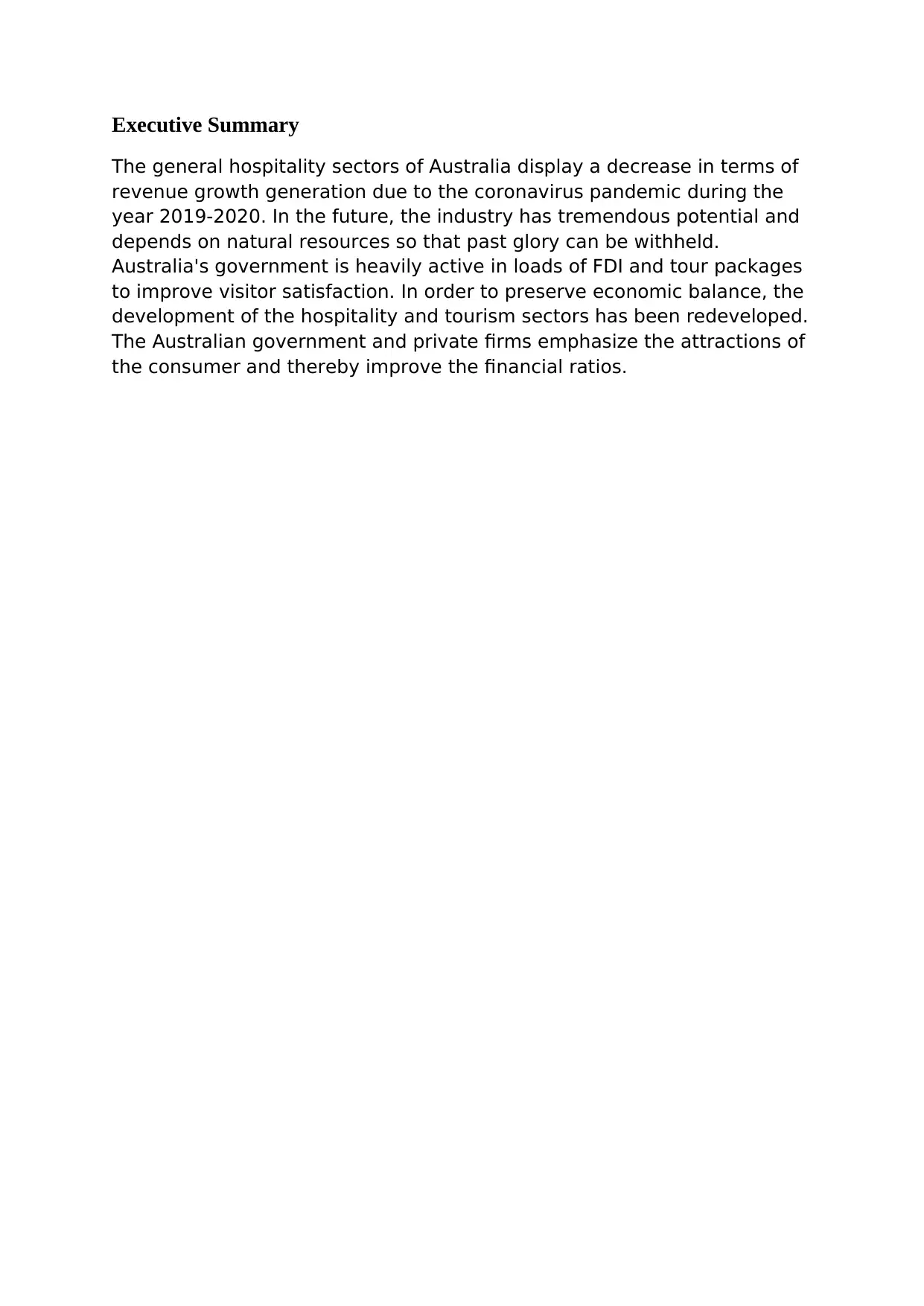
Executive Summary
The general hospitality sectors of Australia display a decrease in terms of
revenue growth generation due to the coronavirus pandemic during the
year 2019-2020. In the future, the industry has tremendous potential and
depends on natural resources so that past glory can be withheld.
Australia's government is heavily active in loads of FDI and tour packages
to improve visitor satisfaction. In order to preserve economic balance, the
development of the hospitality and tourism sectors has been redeveloped.
The Australian government and private firms emphasize the attractions of
the consumer and thereby improve the financial ratios.
The general hospitality sectors of Australia display a decrease in terms of
revenue growth generation due to the coronavirus pandemic during the
year 2019-2020. In the future, the industry has tremendous potential and
depends on natural resources so that past glory can be withheld.
Australia's government is heavily active in loads of FDI and tour packages
to improve visitor satisfaction. In order to preserve economic balance, the
development of the hospitality and tourism sectors has been redeveloped.
The Australian government and private firms emphasize the attractions of
the consumer and thereby improve the financial ratios.
Paraphrase This Document
Need a fresh take? Get an instant paraphrase of this document with our AI Paraphraser
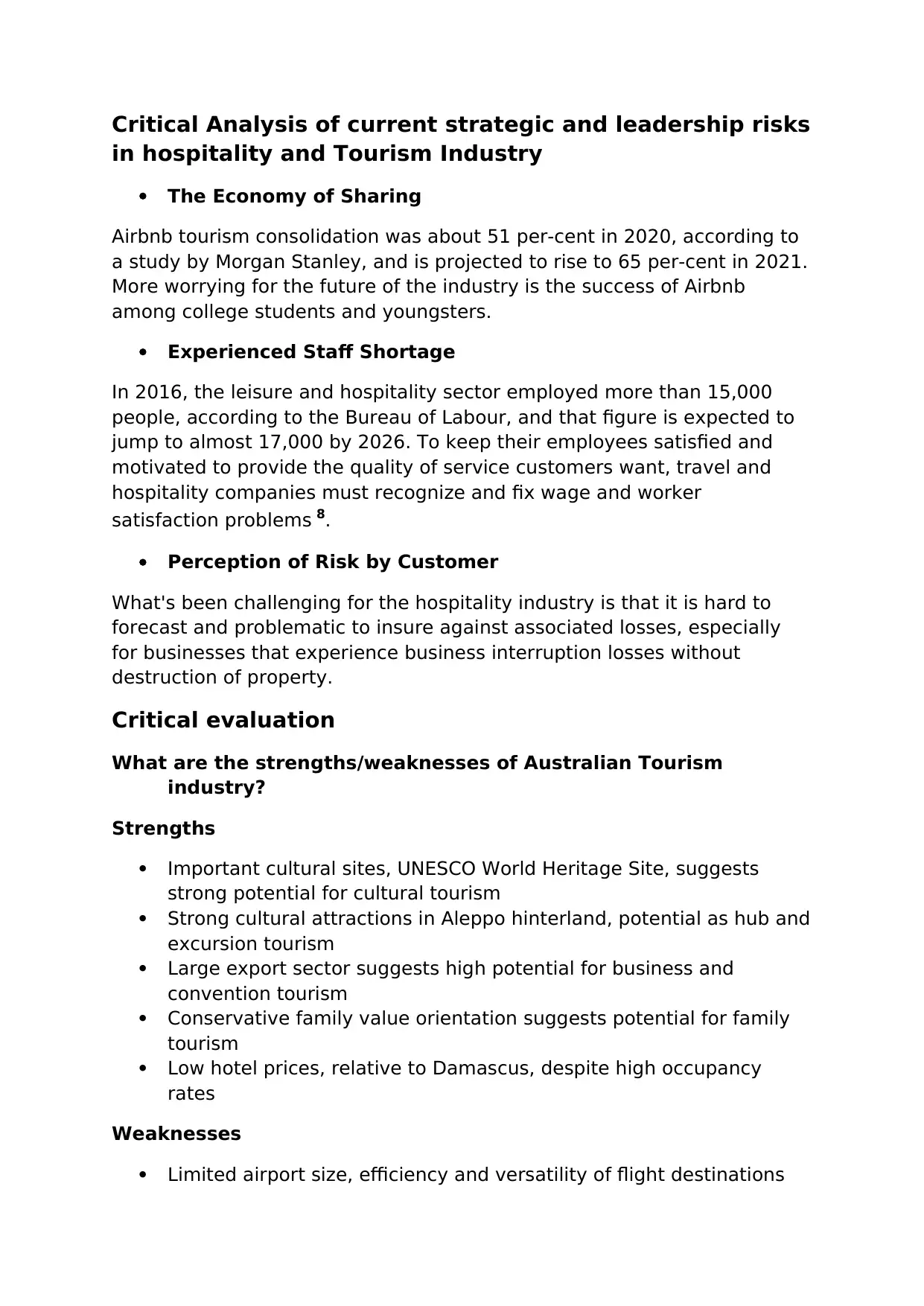
Critical Analysis of current strategic and leadership risks
in hospitality and Tourism Industry
The Economy of Sharing
Airbnb tourism consolidation was about 51 per-cent in 2020, according to
a study by Morgan Stanley, and is projected to rise to 65 per-cent in 2021.
More worrying for the future of the industry is the success of Airbnb
among college students and youngsters.
Experienced Staff Shortage
In 2016, the leisure and hospitality sector employed more than 15,000
people, according to the Bureau of Labour, and that figure is expected to
jump to almost 17,000 by 2026. To keep their employees satisfied and
motivated to provide the quality of service customers want, travel and
hospitality companies must recognize and fix wage and worker
satisfaction problems 8.
Perception of Risk by Customer
What's been challenging for the hospitality industry is that it is hard to
forecast and problematic to insure against associated losses, especially
for businesses that experience business interruption losses without
destruction of property.
Critical evaluation
What are the strengths/weaknesses of Australian Tourism
industry?
Strengths
Important cultural sites, UNESCO World Heritage Site, suggests
strong potential for cultural tourism
Strong cultural attractions in Aleppo hinterland, potential as hub and
excursion tourism
Large export sector suggests high potential for business and
convention tourism
Conservative family value orientation suggests potential for family
tourism
Low hotel prices, relative to Damascus, despite high occupancy
rates
Weaknesses
Limited airport size, efficiency and versatility of flight destinations
in hospitality and Tourism Industry
The Economy of Sharing
Airbnb tourism consolidation was about 51 per-cent in 2020, according to
a study by Morgan Stanley, and is projected to rise to 65 per-cent in 2021.
More worrying for the future of the industry is the success of Airbnb
among college students and youngsters.
Experienced Staff Shortage
In 2016, the leisure and hospitality sector employed more than 15,000
people, according to the Bureau of Labour, and that figure is expected to
jump to almost 17,000 by 2026. To keep their employees satisfied and
motivated to provide the quality of service customers want, travel and
hospitality companies must recognize and fix wage and worker
satisfaction problems 8.
Perception of Risk by Customer
What's been challenging for the hospitality industry is that it is hard to
forecast and problematic to insure against associated losses, especially
for businesses that experience business interruption losses without
destruction of property.
Critical evaluation
What are the strengths/weaknesses of Australian Tourism
industry?
Strengths
Important cultural sites, UNESCO World Heritage Site, suggests
strong potential for cultural tourism
Strong cultural attractions in Aleppo hinterland, potential as hub and
excursion tourism
Large export sector suggests high potential for business and
convention tourism
Conservative family value orientation suggests potential for family
tourism
Low hotel prices, relative to Damascus, despite high occupancy
rates
Weaknesses
Limited airport size, efficiency and versatility of flight destinations
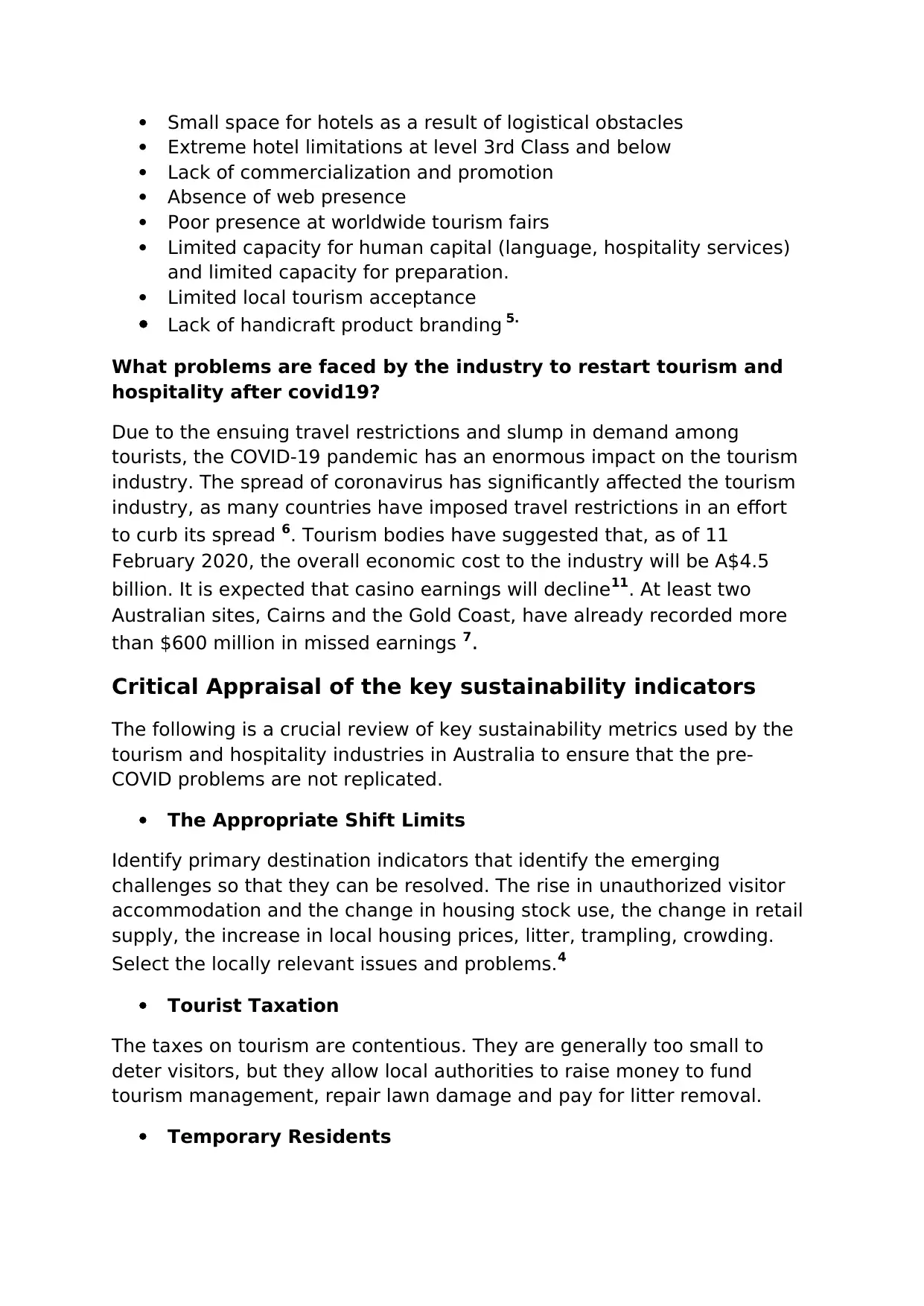
Small space for hotels as a result of logistical obstacles
Extreme hotel limitations at level 3rd Class and below
Lack of commercialization and promotion
Absence of web presence
Poor presence at worldwide tourism fairs
Limited capacity for human capital (language, hospitality services)
and limited capacity for preparation.
Limited local tourism acceptance
Lack of handicraft product branding 5.
What problems are faced by the industry to restart tourism and
hospitality after covid19?
Due to the ensuing travel restrictions and slump in demand among
tourists, the COVID-19 pandemic has an enormous impact on the tourism
industry. The spread of coronavirus has significantly affected the tourism
industry, as many countries have imposed travel restrictions in an effort
to curb its spread 6. Tourism bodies have suggested that, as of 11
February 2020, the overall economic cost to the industry will be A$4.5
billion. It is expected that casino earnings will decline11. At least two
Australian sites, Cairns and the Gold Coast, have already recorded more
than $600 million in missed earnings 7.
Critical Appraisal of the key sustainability indicators
The following is a crucial review of key sustainability metrics used by the
tourism and hospitality industries in Australia to ensure that the pre-
COVID problems are not replicated.
The Appropriate Shift Limits
Identify primary destination indicators that identify the emerging
challenges so that they can be resolved. The rise in unauthorized visitor
accommodation and the change in housing stock use, the change in retail
supply, the increase in local housing prices, litter, trampling, crowding.
Select the locally relevant issues and problems.4
Tourist Taxation
The taxes on tourism are contentious. They are generally too small to
deter visitors, but they allow local authorities to raise money to fund
tourism management, repair lawn damage and pay for litter removal.
Temporary Residents
Extreme hotel limitations at level 3rd Class and below
Lack of commercialization and promotion
Absence of web presence
Poor presence at worldwide tourism fairs
Limited capacity for human capital (language, hospitality services)
and limited capacity for preparation.
Limited local tourism acceptance
Lack of handicraft product branding 5.
What problems are faced by the industry to restart tourism and
hospitality after covid19?
Due to the ensuing travel restrictions and slump in demand among
tourists, the COVID-19 pandemic has an enormous impact on the tourism
industry. The spread of coronavirus has significantly affected the tourism
industry, as many countries have imposed travel restrictions in an effort
to curb its spread 6. Tourism bodies have suggested that, as of 11
February 2020, the overall economic cost to the industry will be A$4.5
billion. It is expected that casino earnings will decline11. At least two
Australian sites, Cairns and the Gold Coast, have already recorded more
than $600 million in missed earnings 7.
Critical Appraisal of the key sustainability indicators
The following is a crucial review of key sustainability metrics used by the
tourism and hospitality industries in Australia to ensure that the pre-
COVID problems are not replicated.
The Appropriate Shift Limits
Identify primary destination indicators that identify the emerging
challenges so that they can be resolved. The rise in unauthorized visitor
accommodation and the change in housing stock use, the change in retail
supply, the increase in local housing prices, litter, trampling, crowding.
Select the locally relevant issues and problems.4
Tourist Taxation
The taxes on tourism are contentious. They are generally too small to
deter visitors, but they allow local authorities to raise money to fund
tourism management, repair lawn damage and pay for litter removal.
Temporary Residents
⊘ This is a preview!⊘
Do you want full access?
Subscribe today to unlock all pages.

Trusted by 1+ million students worldwide
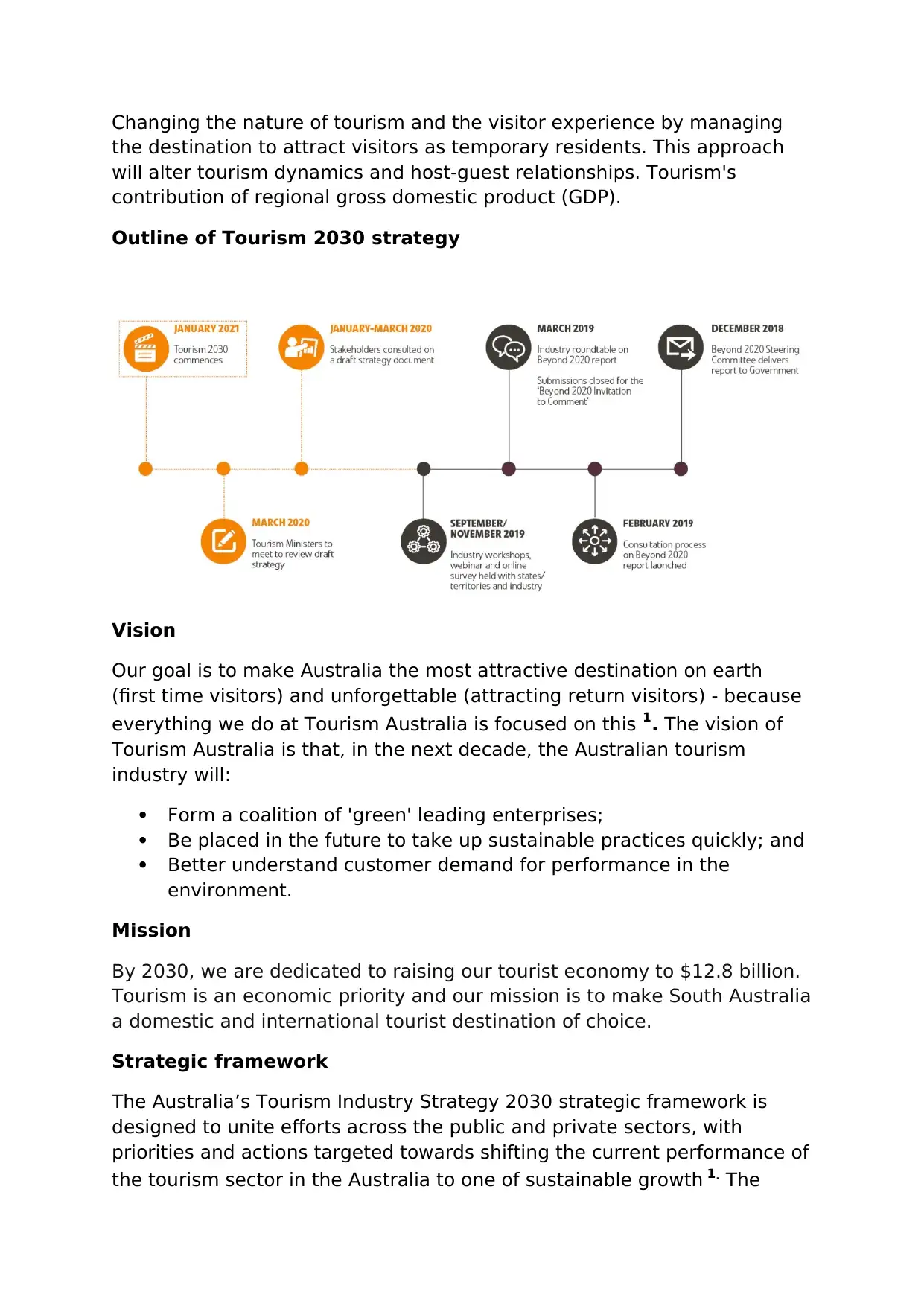
Changing the nature of tourism and the visitor experience by managing
the destination to attract visitors as temporary residents. This approach
will alter tourism dynamics and host-guest relationships. Tourism's
contribution of regional gross domestic product (GDP).
Outline of Tourism 2030 strategy
Vision
Our goal is to make Australia the most attractive destination on earth
(first time visitors) and unforgettable (attracting return visitors) - because
everything we do at Tourism Australia is focused on this 1. The vision of
Tourism Australia is that, in the next decade, the Australian tourism
industry will:
Form a coalition of 'green' leading enterprises;
Be placed in the future to take up sustainable practices quickly; and
Better understand customer demand for performance in the
environment.
Mission
By 2030, we are dedicated to raising our tourist economy to $12.8 billion.
Tourism is an economic priority and our mission is to make South Australia
a domestic and international tourist destination of choice.
Strategic framework
The Australia’s Tourism Industry Strategy 2030 strategic framework is
designed to unite efforts across the public and private sectors, with
priorities and actions targeted towards shifting the current performance of
the tourism sector in the Australia to one of sustainable growth 1. The
the destination to attract visitors as temporary residents. This approach
will alter tourism dynamics and host-guest relationships. Tourism's
contribution of regional gross domestic product (GDP).
Outline of Tourism 2030 strategy
Vision
Our goal is to make Australia the most attractive destination on earth
(first time visitors) and unforgettable (attracting return visitors) - because
everything we do at Tourism Australia is focused on this 1. The vision of
Tourism Australia is that, in the next decade, the Australian tourism
industry will:
Form a coalition of 'green' leading enterprises;
Be placed in the future to take up sustainable practices quickly; and
Better understand customer demand for performance in the
environment.
Mission
By 2030, we are dedicated to raising our tourist economy to $12.8 billion.
Tourism is an economic priority and our mission is to make South Australia
a domestic and international tourist destination of choice.
Strategic framework
The Australia’s Tourism Industry Strategy 2030 strategic framework is
designed to unite efforts across the public and private sectors, with
priorities and actions targeted towards shifting the current performance of
the tourism sector in the Australia to one of sustainable growth 1. The
Paraphrase This Document
Need a fresh take? Get an instant paraphrase of this document with our AI Paraphraser
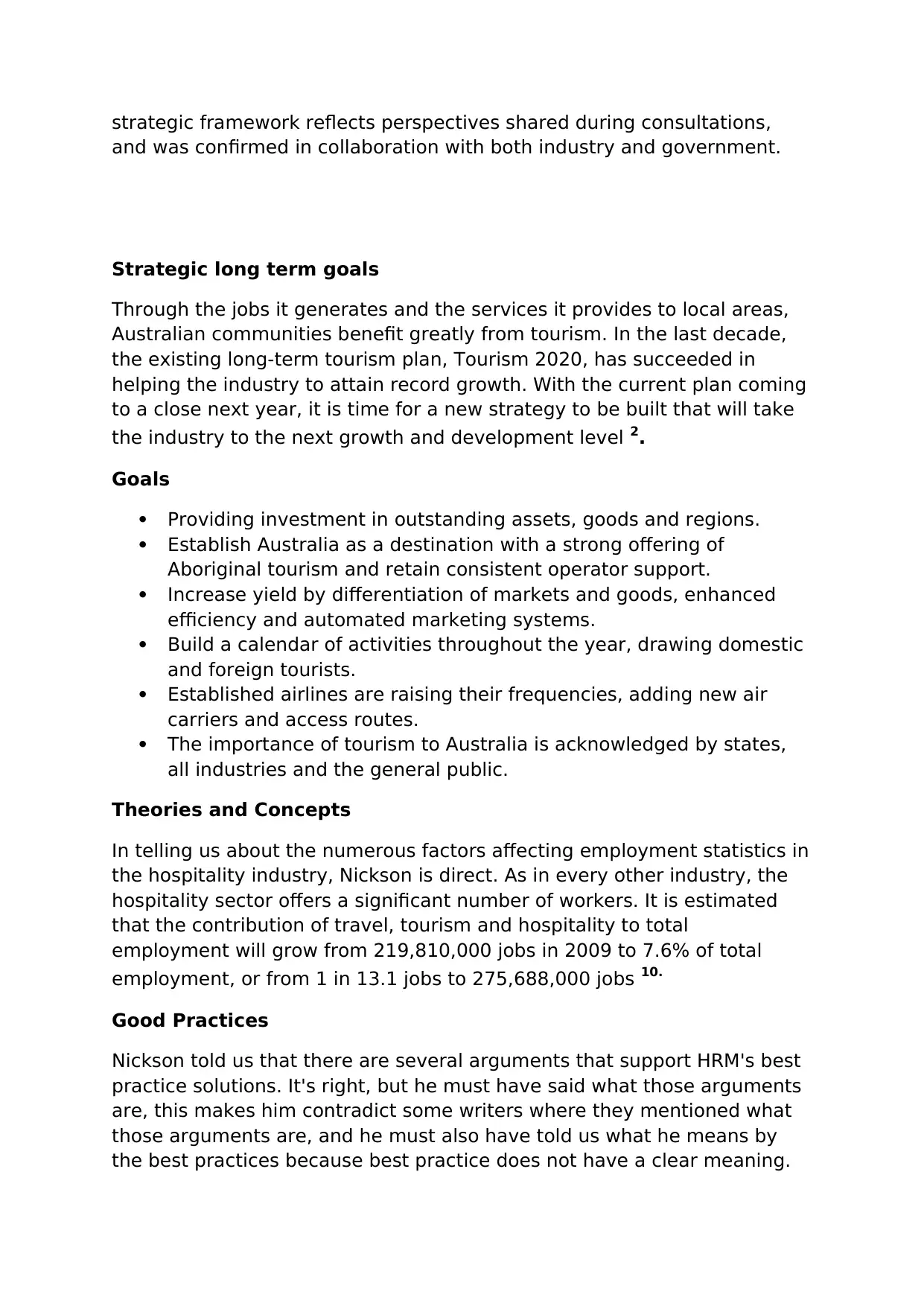
strategic framework reflects perspectives shared during consultations,
and was confirmed in collaboration with both industry and government.
Strategic long term goals
Through the jobs it generates and the services it provides to local areas,
Australian communities benefit greatly from tourism. In the last decade,
the existing long-term tourism plan, Tourism 2020, has succeeded in
helping the industry to attain record growth. With the current plan coming
to a close next year, it is time for a new strategy to be built that will take
the industry to the next growth and development level 2.
Goals
Providing investment in outstanding assets, goods and regions.
Establish Australia as a destination with a strong offering of
Aboriginal tourism and retain consistent operator support.
Increase yield by differentiation of markets and goods, enhanced
efficiency and automated marketing systems.
Build a calendar of activities throughout the year, drawing domestic
and foreign tourists.
Established airlines are raising their frequencies, adding new air
carriers and access routes.
The importance of tourism to Australia is acknowledged by states,
all industries and the general public.
Theories and Concepts
In telling us about the numerous factors affecting employment statistics in
the hospitality industry, Nickson is direct. As in every other industry, the
hospitality sector offers a significant number of workers. It is estimated
that the contribution of travel, tourism and hospitality to total
employment will grow from 219,810,000 jobs in 2009 to 7.6% of total
employment, or from 1 in 13.1 jobs to 275,688,000 jobs 10.
Good Practices
Nickson told us that there are several arguments that support HRM's best
practice solutions. It's right, but he must have said what those arguments
are, this makes him contradict some writers where they mentioned what
those arguments are, and he must also have told us what he means by
the best practices because best practice does not have a clear meaning.
and was confirmed in collaboration with both industry and government.
Strategic long term goals
Through the jobs it generates and the services it provides to local areas,
Australian communities benefit greatly from tourism. In the last decade,
the existing long-term tourism plan, Tourism 2020, has succeeded in
helping the industry to attain record growth. With the current plan coming
to a close next year, it is time for a new strategy to be built that will take
the industry to the next growth and development level 2.
Goals
Providing investment in outstanding assets, goods and regions.
Establish Australia as a destination with a strong offering of
Aboriginal tourism and retain consistent operator support.
Increase yield by differentiation of markets and goods, enhanced
efficiency and automated marketing systems.
Build a calendar of activities throughout the year, drawing domestic
and foreign tourists.
Established airlines are raising their frequencies, adding new air
carriers and access routes.
The importance of tourism to Australia is acknowledged by states,
all industries and the general public.
Theories and Concepts
In telling us about the numerous factors affecting employment statistics in
the hospitality industry, Nickson is direct. As in every other industry, the
hospitality sector offers a significant number of workers. It is estimated
that the contribution of travel, tourism and hospitality to total
employment will grow from 219,810,000 jobs in 2009 to 7.6% of total
employment, or from 1 in 13.1 jobs to 275,688,000 jobs 10.
Good Practices
Nickson told us that there are several arguments that support HRM's best
practice solutions. It's right, but he must have said what those arguments
are, this makes him contradict some writers where they mentioned what
those arguments are, and he must also have told us what he means by
the best practices because best practice does not have a clear meaning.
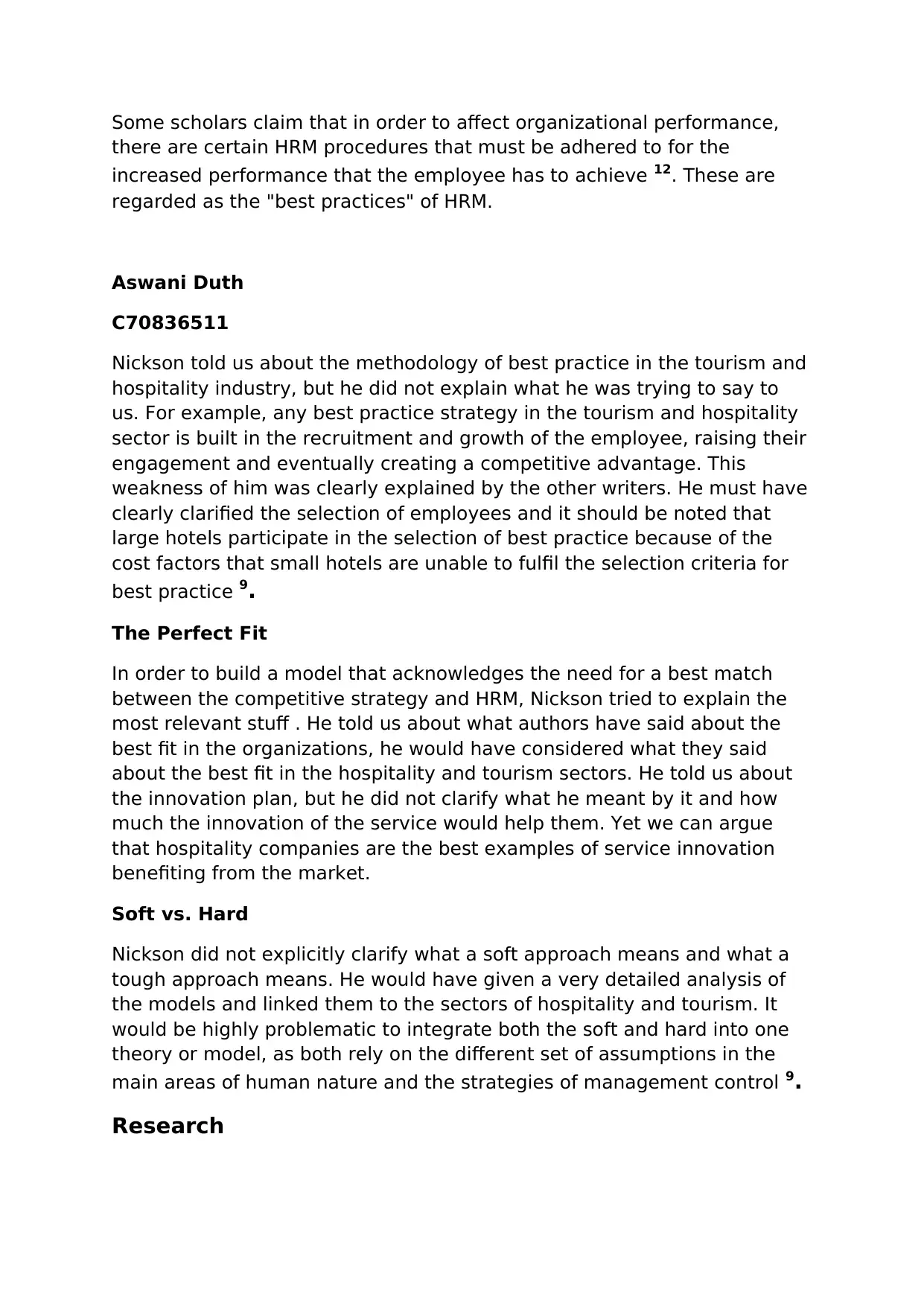
Some scholars claim that in order to affect organizational performance,
there are certain HRM procedures that must be adhered to for the
increased performance that the employee has to achieve 12. These are
regarded as the "best practices" of HRM.
Aswani Duth
C70836511
Nickson told us about the methodology of best practice in the tourism and
hospitality industry, but he did not explain what he was trying to say to
us. For example, any best practice strategy in the tourism and hospitality
sector is built in the recruitment and growth of the employee, raising their
engagement and eventually creating a competitive advantage. This
weakness of him was clearly explained by the other writers. He must have
clearly clarified the selection of employees and it should be noted that
large hotels participate in the selection of best practice because of the
cost factors that small hotels are unable to fulfil the selection criteria for
best practice 9.
The Perfect Fit
In order to build a model that acknowledges the need for a best match
between the competitive strategy and HRM, Nickson tried to explain the
most relevant stuff . He told us about what authors have said about the
best fit in the organizations, he would have considered what they said
about the best fit in the hospitality and tourism sectors. He told us about
the innovation plan, but he did not clarify what he meant by it and how
much the innovation of the service would help them. Yet we can argue
that hospitality companies are the best examples of service innovation
benefiting from the market.
Soft vs. Hard
Nickson did not explicitly clarify what a soft approach means and what a
tough approach means. He would have given a very detailed analysis of
the models and linked them to the sectors of hospitality and tourism. It
would be highly problematic to integrate both the soft and hard into one
theory or model, as both rely on the different set of assumptions in the
main areas of human nature and the strategies of management control 9.
Research
there are certain HRM procedures that must be adhered to for the
increased performance that the employee has to achieve 12. These are
regarded as the "best practices" of HRM.
Aswani Duth
C70836511
Nickson told us about the methodology of best practice in the tourism and
hospitality industry, but he did not explain what he was trying to say to
us. For example, any best practice strategy in the tourism and hospitality
sector is built in the recruitment and growth of the employee, raising their
engagement and eventually creating a competitive advantage. This
weakness of him was clearly explained by the other writers. He must have
clearly clarified the selection of employees and it should be noted that
large hotels participate in the selection of best practice because of the
cost factors that small hotels are unable to fulfil the selection criteria for
best practice 9.
The Perfect Fit
In order to build a model that acknowledges the need for a best match
between the competitive strategy and HRM, Nickson tried to explain the
most relevant stuff . He told us about what authors have said about the
best fit in the organizations, he would have considered what they said
about the best fit in the hospitality and tourism sectors. He told us about
the innovation plan, but he did not clarify what he meant by it and how
much the innovation of the service would help them. Yet we can argue
that hospitality companies are the best examples of service innovation
benefiting from the market.
Soft vs. Hard
Nickson did not explicitly clarify what a soft approach means and what a
tough approach means. He would have given a very detailed analysis of
the models and linked them to the sectors of hospitality and tourism. It
would be highly problematic to integrate both the soft and hard into one
theory or model, as both rely on the different set of assumptions in the
main areas of human nature and the strategies of management control 9.
Research
⊘ This is a preview!⊘
Do you want full access?
Subscribe today to unlock all pages.

Trusted by 1+ million students worldwide
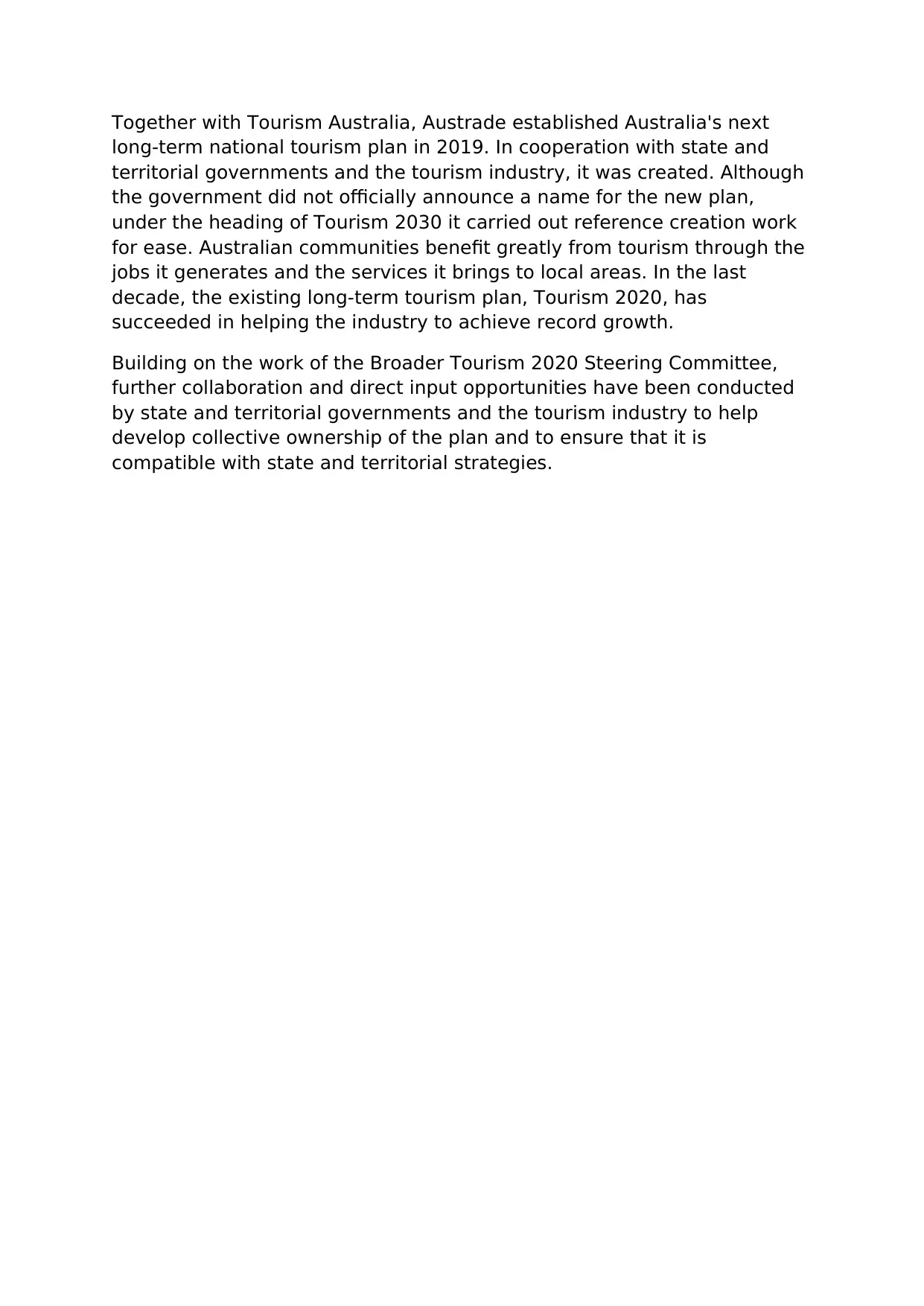
Together with Tourism Australia, Austrade established Australia's next
long-term national tourism plan in 2019. In cooperation with state and
territorial governments and the tourism industry, it was created. Although
the government did not officially announce a name for the new plan,
under the heading of Tourism 2030 it carried out reference creation work
for ease. Australian communities benefit greatly from tourism through the
jobs it generates and the services it brings to local areas. In the last
decade, the existing long-term tourism plan, Tourism 2020, has
succeeded in helping the industry to achieve record growth.
Building on the work of the Broader Tourism 2020 Steering Committee,
further collaboration and direct input opportunities have been conducted
by state and territorial governments and the tourism industry to help
develop collective ownership of the plan and to ensure that it is
compatible with state and territorial strategies.
long-term national tourism plan in 2019. In cooperation with state and
territorial governments and the tourism industry, it was created. Although
the government did not officially announce a name for the new plan,
under the heading of Tourism 2030 it carried out reference creation work
for ease. Australian communities benefit greatly from tourism through the
jobs it generates and the services it brings to local areas. In the last
decade, the existing long-term tourism plan, Tourism 2020, has
succeeded in helping the industry to achieve record growth.
Building on the work of the Broader Tourism 2020 Steering Committee,
further collaboration and direct input opportunities have been conducted
by state and territorial governments and the tourism industry to help
develop collective ownership of the plan and to ensure that it is
compatible with state and territorial strategies.
Paraphrase This Document
Need a fresh take? Get an instant paraphrase of this document with our AI Paraphraser
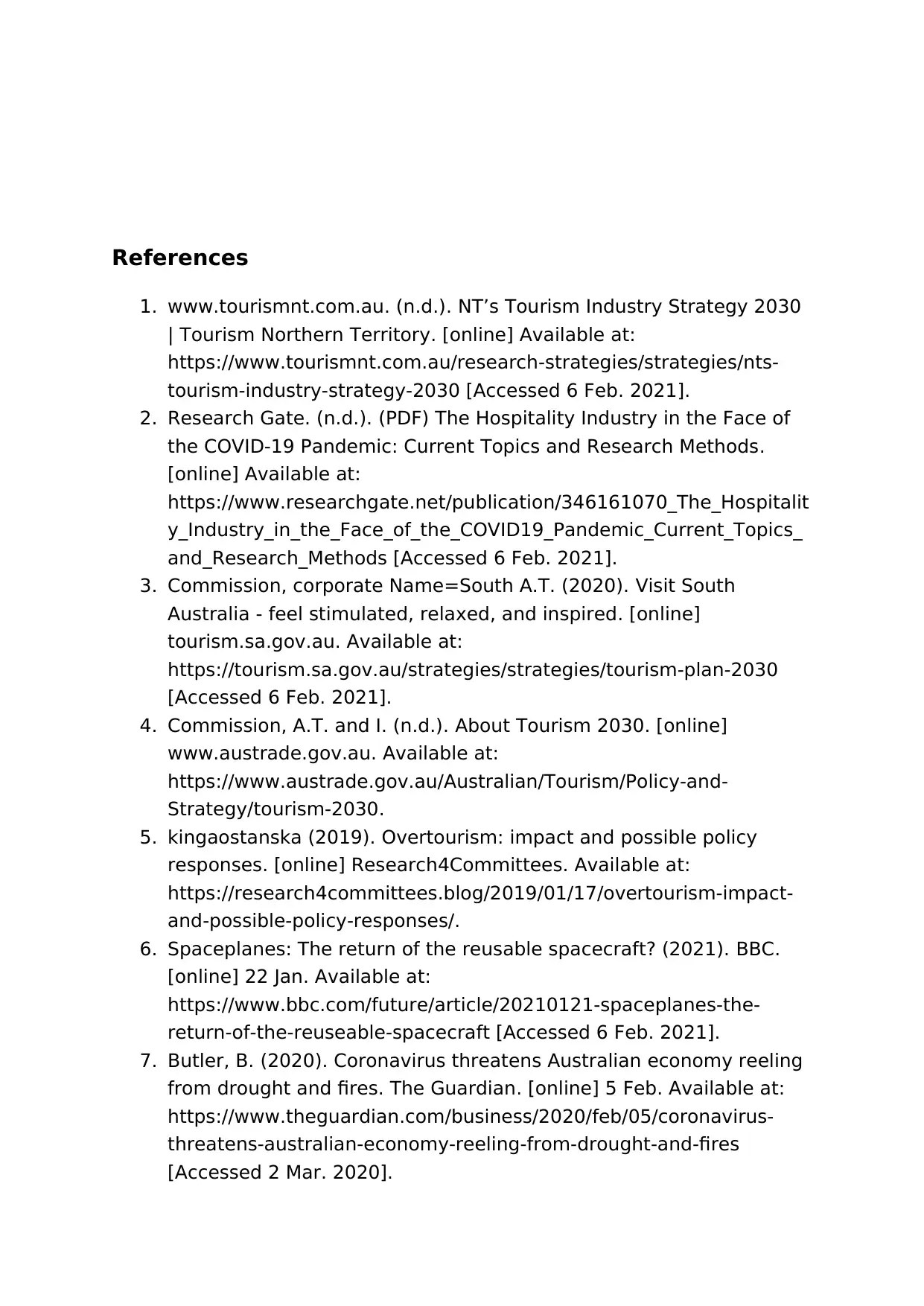
References
1. www.tourismnt.com.au. (n.d.). NT’s Tourism Industry Strategy 2030
| Tourism Northern Territory. [online] Available at:
https://www.tourismnt.com.au/research-strategies/strategies/nts-
tourism-industry-strategy-2030 [Accessed 6 Feb. 2021].
2. Research Gate. (n.d.). (PDF) The Hospitality Industry in the Face of
the COVID-19 Pandemic: Current Topics and Research Methods.
[online] Available at:
https://www.researchgate.net/publication/346161070_The_Hospitalit
y_Industry_in_the_Face_of_the_COVID19_Pandemic_Current_Topics_
and_Research_Methods [Accessed 6 Feb. 2021].
3. Commission, corporate Name=South A.T. (2020). Visit South
Australia - feel stimulated, relaxed, and inspired. [online]
tourism.sa.gov.au. Available at:
https://tourism.sa.gov.au/strategies/strategies/tourism-plan-2030
[Accessed 6 Feb. 2021].
4. Commission, A.T. and I. (n.d.). About Tourism 2030. [online]
www.austrade.gov.au. Available at:
https://www.austrade.gov.au/Australian/Tourism/Policy-and-
Strategy/tourism-2030.
5. kingaostanska (2019). Overtourism: impact and possible policy
responses. [online] Research4Committees. Available at:
https://research4committees.blog/2019/01/17/overtourism-impact-
and-possible-policy-responses/.
6. Spaceplanes: The return of the reusable spacecraft? (2021). BBC.
[online] 22 Jan. Available at:
https://www.bbc.com/future/article/20210121-spaceplanes-the-
return-of-the-reuseable-spacecraft [Accessed 6 Feb. 2021].
7. Butler, B. (2020). Coronavirus threatens Australian economy reeling
from drought and fires. The Guardian. [online] 5 Feb. Available at:
https://www.theguardian.com/business/2020/feb/05/coronavirus-
threatens-australian-economy-reeling-from-drought-and-fires
[Accessed 2 Mar. 2020].
1. www.tourismnt.com.au. (n.d.). NT’s Tourism Industry Strategy 2030
| Tourism Northern Territory. [online] Available at:
https://www.tourismnt.com.au/research-strategies/strategies/nts-
tourism-industry-strategy-2030 [Accessed 6 Feb. 2021].
2. Research Gate. (n.d.). (PDF) The Hospitality Industry in the Face of
the COVID-19 Pandemic: Current Topics and Research Methods.
[online] Available at:
https://www.researchgate.net/publication/346161070_The_Hospitalit
y_Industry_in_the_Face_of_the_COVID19_Pandemic_Current_Topics_
and_Research_Methods [Accessed 6 Feb. 2021].
3. Commission, corporate Name=South A.T. (2020). Visit South
Australia - feel stimulated, relaxed, and inspired. [online]
tourism.sa.gov.au. Available at:
https://tourism.sa.gov.au/strategies/strategies/tourism-plan-2030
[Accessed 6 Feb. 2021].
4. Commission, A.T. and I. (n.d.). About Tourism 2030. [online]
www.austrade.gov.au. Available at:
https://www.austrade.gov.au/Australian/Tourism/Policy-and-
Strategy/tourism-2030.
5. kingaostanska (2019). Overtourism: impact and possible policy
responses. [online] Research4Committees. Available at:
https://research4committees.blog/2019/01/17/overtourism-impact-
and-possible-policy-responses/.
6. Spaceplanes: The return of the reusable spacecraft? (2021). BBC.
[online] 22 Jan. Available at:
https://www.bbc.com/future/article/20210121-spaceplanes-the-
return-of-the-reuseable-spacecraft [Accessed 6 Feb. 2021].
7. Butler, B. (2020). Coronavirus threatens Australian economy reeling
from drought and fires. The Guardian. [online] 5 Feb. Available at:
https://www.theguardian.com/business/2020/feb/05/coronavirus-
threatens-australian-economy-reeling-from-drought-and-fires
[Accessed 2 Mar. 2020].
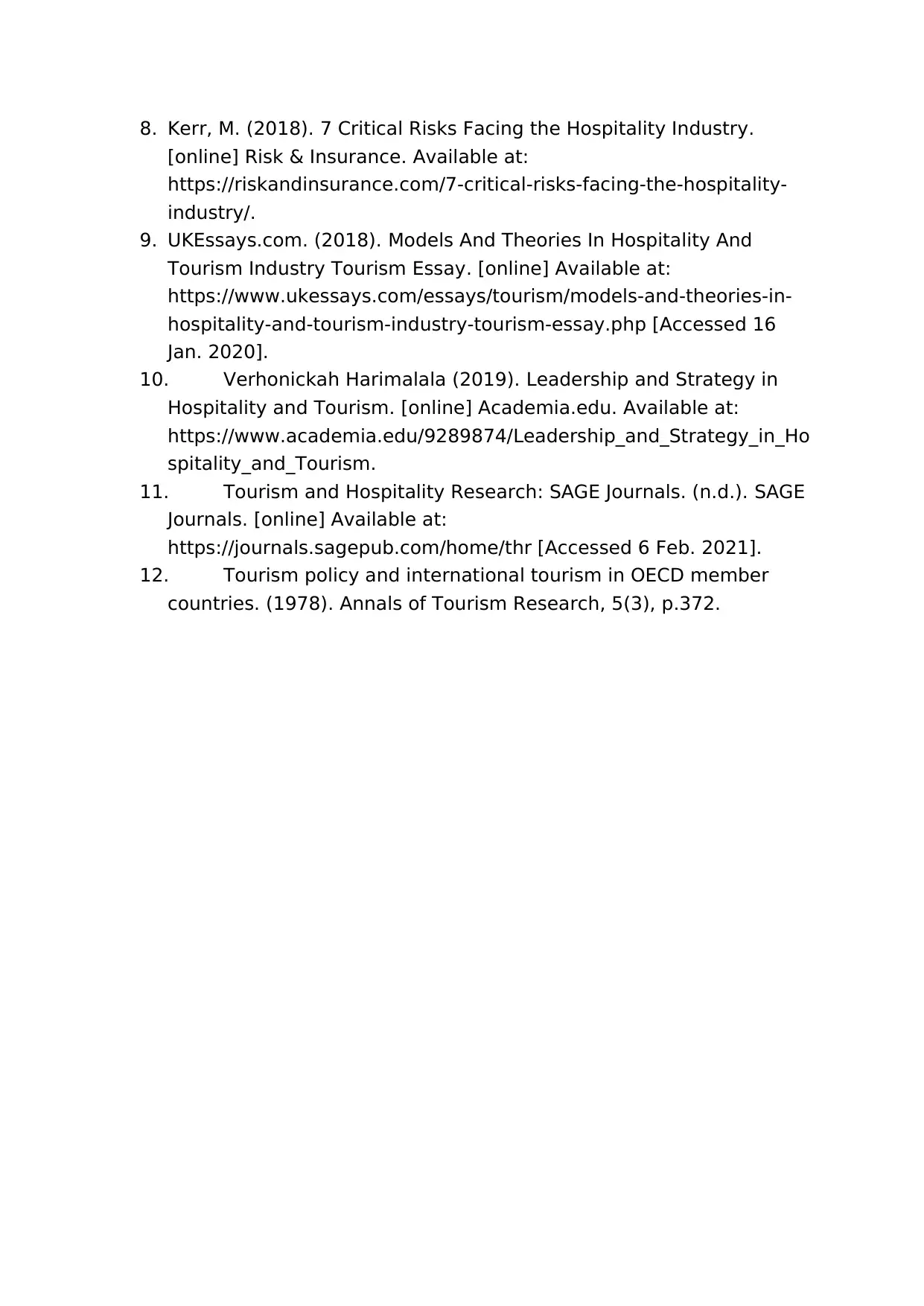
8. Kerr, M. (2018). 7 Critical Risks Facing the Hospitality Industry.
[online] Risk & Insurance. Available at:
https://riskandinsurance.com/7-critical-risks-facing-the-hospitality-
industry/.
9. UKEssays.com. (2018). Models And Theories In Hospitality And
Tourism Industry Tourism Essay. [online] Available at:
https://www.ukessays.com/essays/tourism/models-and-theories-in-
hospitality-and-tourism-industry-tourism-essay.php [Accessed 16
Jan. 2020].
10. Verhonickah Harimalala (2019). Leadership and Strategy in
Hospitality and Tourism. [online] Academia.edu. Available at:
https://www.academia.edu/9289874/Leadership_and_Strategy_in_Ho
spitality_and_Tourism.
11. Tourism and Hospitality Research: SAGE Journals. (n.d.). SAGE
Journals. [online] Available at:
https://journals.sagepub.com/home/thr [Accessed 6 Feb. 2021].
12. Tourism policy and international tourism in OECD member
countries. (1978). Annals of Tourism Research, 5(3), p.372.
[online] Risk & Insurance. Available at:
https://riskandinsurance.com/7-critical-risks-facing-the-hospitality-
industry/.
9. UKEssays.com. (2018). Models And Theories In Hospitality And
Tourism Industry Tourism Essay. [online] Available at:
https://www.ukessays.com/essays/tourism/models-and-theories-in-
hospitality-and-tourism-industry-tourism-essay.php [Accessed 16
Jan. 2020].
10. Verhonickah Harimalala (2019). Leadership and Strategy in
Hospitality and Tourism. [online] Academia.edu. Available at:
https://www.academia.edu/9289874/Leadership_and_Strategy_in_Ho
spitality_and_Tourism.
11. Tourism and Hospitality Research: SAGE Journals. (n.d.). SAGE
Journals. [online] Available at:
https://journals.sagepub.com/home/thr [Accessed 6 Feb. 2021].
12. Tourism policy and international tourism in OECD member
countries. (1978). Annals of Tourism Research, 5(3), p.372.
⊘ This is a preview!⊘
Do you want full access?
Subscribe today to unlock all pages.

Trusted by 1+ million students worldwide
1 out of 9
Related Documents
Your All-in-One AI-Powered Toolkit for Academic Success.
+13062052269
info@desklib.com
Available 24*7 on WhatsApp / Email
![[object Object]](/_next/static/media/star-bottom.7253800d.svg)
Unlock your academic potential
Copyright © 2020–2025 A2Z Services. All Rights Reserved. Developed and managed by ZUCOL.



